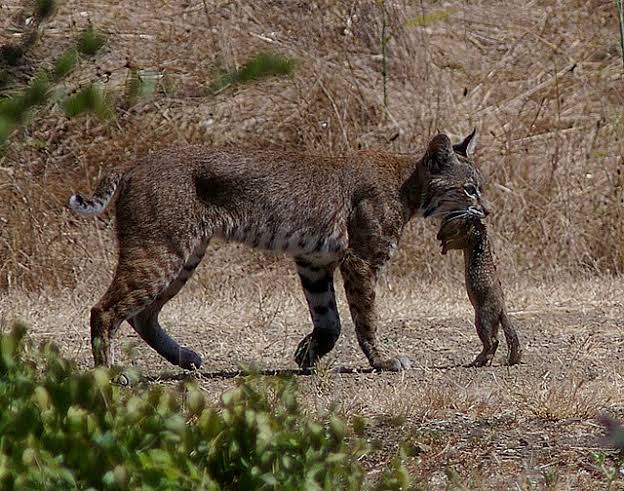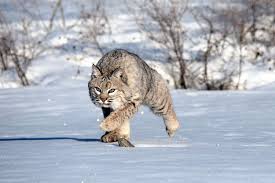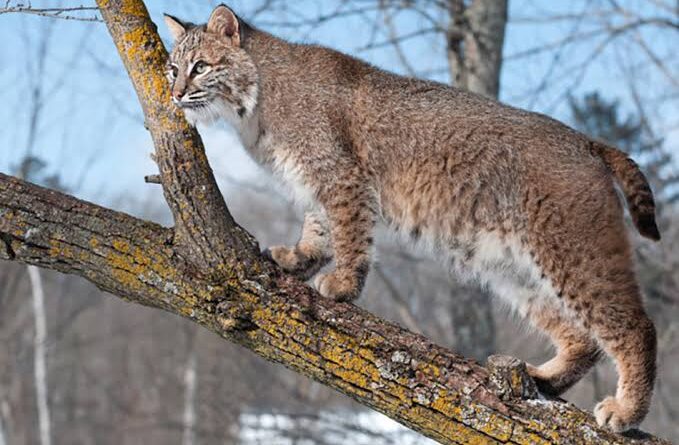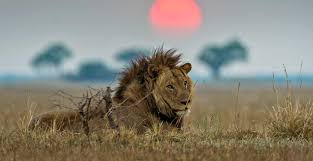Bobcats: Description, Damages Caused, Control and Preventive Measures
Bobcats scientifically known as Lynx rufus are fascinating creatures that inhabit various regions of North America. These medium-sized wild cats have a distinctive appearance with their short tails, tufted ears, and spotted fur.
In the wild, bobcats are known for their solitary nature, preferring to roam and hunt alone. Their scientific name, Lynx rufus, reflects their close relation to other lynx species. Despite their solitary habits, bobcats play a crucial role in maintaining a balanced ecosystem by controlling the population of smaller mammals like rabbits and rodents.
The fur of bobcats is marked with a mixture of spots and stripes, providing them with effective camouflage in their natural habitats. This adaptable coat helps them blend seamlessly into a variety of environments, from dense forests to arid deserts.
Bobcats are skilled hunters, relying on their keen senses of sight and hearing to locate prey. Their diet includes small mammals, birds, and occasionally larger prey when the opportunity arises. With powerful hind legs, bobcats are capable of impressive leaps, aiding them in pouncing on unsuspecting prey.
The elusive nature of bobcats makes them challenging to observe in the wild. They are known for their secretive behavior, often avoiding human interaction and maintaining a low profile. Despite this, bobcats have adapted to living in proximity to human settlements, occasionally venturing into suburban areas in search of food.
Conservation efforts are essential to ensure the survival of bobcat populations. Threats such as habitat loss, human-wildlife conflict, and illegal hunting pose challenges to their well-being. Understanding and respecting the natural behaviors of these wild cats is crucial for fostering coexistence between humans and bobcats.
However, bobcats, scientifically known as Lynx rufus, contribute significantly to the biodiversity of North American ecosystems. Their adaptability, hunting prowess, and unique physical features make them a captivating species worthy of conservation efforts. Understanding and appreciating these elusive creatures can promote a harmonious balance between humans and the diverse wildlife that shares our planet.
Read Also: Coccidiosis in Poultry: Signs, Drugs and Treatment
Animals Affected by Bobcats (Lynx rufus)

Bobcats, with their role as skilled predators, have an impact on the populations of various animals in their ecosystems. Small mammals are particularly affected, as bobcats primarily prey on creatures like rabbits, squirrels, and rodents. This predation helps control the populations of these smaller mammals, preventing overpopulation and maintaining a balance in the ecosystem.
Birds also fall within the scope of the bobcat’s hunting preferences. Ground-nesting birds and those with nests at lower elevations may be vulnerable to bobcat predation. However, it’s important to note that bobcats do not solely rely on birds as a primary food source.
In some instances, bobcats may target larger prey such as deer, especially when smaller prey is scarce. While they are not as specialized for taking down larger animals as some larger predators, bobcats can still have an impact on deer populations in certain regions.
The presence of bobcats in an area can influence the behavior and distribution of their prey. Small mammals may alter their activity patterns or select different habitats to avoid predation, creating a ripple effect on the entire ecosystem.
It’s essential to recognize that the relationship between bobcats and other animals is part of the intricate web of nature. The interactions between predators like bobcats and their prey contribute to the overall health and functioning of ecosystems, highlighting the interconnectedness of wildlife in the natural world.
Damages Caused by Bobcats

Bobcats, while playing a crucial role in maintaining ecological balance, can occasionally cause certain challenges or damages in specific situations. Understanding these aspects is essential for fostering coexistence between humans and these wild cats.
1. Livestock Predation: In areas where bobcats overlap with domesticated animals, such as farms or ranches, there can be instances of livestock predation. Bobcats may target poultry, small goats, or other vulnerable animals, leading to economic losses for farmers.
2. Pet Threats: Bobcats may pose a threat to small domestic pets, especially in suburban or rural areas. Unattended pets, such as small dogs or outdoor cats, could become targets for bobcats. Ensuring the safety of domestic animals in regions with bobcat populations is crucial.
3. Garden and Crop Damage: In some cases, bobcats may enter gardens or fields in search of prey. While their primary targets are wildlife, the presence of bobcats near human habitation can result in occasional damage to crops or garden areas.
4. Human-Wildlife Conflict: Bobcats are generally elusive and tend to avoid human interaction. However, as urban areas expand into wildlife habitats, there can be increased instances of human-wildlife conflict. Bobcats may be spotted in suburban neighborhoods, leading to concerns among residents.
5. Vehicle Collisions: Like many wild animals, bobcats are at risk of being involved in vehicle collisions. As roads and highways traverse through their habitats, bobcats may face dangers from traffic. This not only poses a threat to the bobcats but can also result in damage to vehicles.
While these challenges exist, it’s important to approach bobcat management with a focus on conservation and coexistence. Implementing measures to protect livestock, securing pets, and promoting responsible urban planning are ways to mitigate potential damages while respecting the natural behaviors of bobcats in their ecosystems. Balancing the needs of both wildlife and human communities is crucial for maintaining a harmonious relationship with these elusive predators.
Read Also: A Step-by-Step Guide To Raising Backyard Chickens
Control and Preventive Measures

Implementing effective control and preventive measures is essential for managing potential conflicts between bobcats and human activities. Here are several strategies that can be employed:
1. Secure Livestock and Pets: To minimize livestock predation and protect domestic pets, it’s crucial for farmers and pet owners to implement secure enclosures. Fencing and secure shelters can help prevent bobcats from accessing vulnerable animals.
2. Avoid Feeding Wildlife: Providing food sources for wildlife, intentionally or unintentionally, can attract bobcats to residential areas. Avoid leaving pet food outdoors and secure garbage bins to discourage scavenging by these wild cats.
3. Educate the Public: Increasing public awareness about bobcats and their behaviors is vital. Educating residents in areas with bobcat populations can help reduce unnecessary fear and promote coexistence. This includes providing information on how to safely coexist with wildlife.
4. Wildlife Corridors: Implementing and preserving wildlife corridors can allow bobcats and other wildlife to move freely between habitats, reducing the likelihood of them entering urban or suburban areas in search of resources.
5. Traffic Safety Measures: To reduce the risk of vehicle collisions with bobcats, implementing speed limits in areas known to have wildlife crossings, and putting up warning signs can be effective measures. Additionally, educating drivers about the presence of wildlife can enhance road safety.
6. Conservation of Natural Habitats: Protecting and preserving natural habitats is fundamental for the well-being of bobcat populations. Conservation efforts should focus on maintaining diverse ecosystems, ensuring sufficient prey availability, and minimizing habitat fragmentation.
7. Research and Monitoring: Continued research on bobcat behavior, population dynamics, and their interactions with human activities is essential. Monitoring bobcat populations helps inform conservation strategies and allows for adaptive management.
8. Implementing Local Ordinances: Some regions may need specific regulations or ordinances to address bobcat-human interactions. These could include guidelines for managing attractants, reporting sightings, and implementing measures to protect both people and wildlife.
It’s crucial to strike a balance between conservation efforts and the needs of local residents, ultimately promoting harmony between humans and these elusive wild cats.
Frequently Asked Questions (FAQs) About Bobcats (Lynx rufus)
1. Q: What is the scientific name of a bobcat?
A: The scientific name of a bobcat is Lynx rufus.
2. Q: Where do bobcats live?
A: Bobcats are found in various habitats across North America, including forests, deserts, swamps, and urban areas.
3. Q: What do bobcats eat?
A: Bobcats are carnivores and primarily feed on small mammals like rabbits, squirrels, and rodents. They may also consume birds and occasionally larger prey such as deer.
4. Q: Are bobcats dangerous to humans?
A: Bobcats are generally elusive and tend to avoid human interaction. While they are not considered a significant threat to humans, it’s essential to exercise caution and avoid approaching or provoking them.
5. Q: How big do bobcats get?
A: Adult bobcats typically weigh between 15 to 35 pounds, with males generally larger than females. They have a body length ranging from 28 to 40 inches and a short tail of about 4 to 8 inches.
6. Q: Do bobcats make good pets?
A: Bobcats are wild animals and are not suitable as pets. Keeping them as pets is often illegal and poses significant challenges due to their natural behaviors and specialized needs.
7. Q: How do bobcats communicate?
A: Bobcats communicate through vocalizations such as growls, yowls, and screams. They also use scent marking and body language to convey information to other bobcats.
8. Q: Are bobcats endangered?
A: Bobcats are not currently considered endangered. However, they face threats from habitat loss, human-wildlife conflict, and illegal hunting. Conservation efforts are crucial to ensure their continued well-being.
9. Q: What should I do if I encounter a bobcat?
A: If you encounter a bobcat, remain calm, and avoid direct eye contact. Back away slowly and give the bobcat space to retreat. Do not run or turn your back, and make loud noises to deter the bobcat from approaching.
10. Q: Can bobcats be relocated if they are causing issues?
A: Relocating bobcats is generally not recommended, as it can be stressful for the animals and may not resolve the underlying issues. Instead, implementing preventive measures and educating the community about coexistence is often more effective.
Read Also: How to Market Your Business









